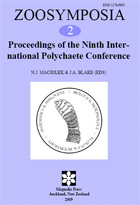Abstract
This paper describes the polychaete fauna in Salsipuedes Bay, Baja California. Sea-cage farming results in a rain of organic matter onto the underlying benthos. There is growing concern over the effects of tuna sea-cages on the local sediment chemistry and benthic communities. Eighteen stations were sampled with a Van Veen grab (0.1 m2) from the oceanographic vessel Francisco de Ulloa in March 2003 and October 2004. Redox potential in 2003 ranged between ‑113 and ‑200 mV, while in 2004 it ranged between ‑110 and ‑302 mV. Organic carbon concentrations varied between 0.20% and 2.53 %, lowest values were located in the southern part of the bay; highest concentrations were found at stations 18–22 situated in the northern section, west of the tuna pens. Organic N varied between 0.02% and0.12%, highest concentrations (0.07–0.12%) were located at stations 16–21 in the northern section of the bay; stations situated at the south and near the coast presented the lowest N concentrations (0.02–0.04%).
A total of 9,291 organisms belonging to seven phyla were collected: Polychaeta, Mollusca, Crustacea, Echinodermata, Cnidaria, Sipuncula, and Bryozoa. Polychaetes accounted for 62% of all invertebrate macrofauna, with 5,765 specimens representing 34 families and 146 species. The best represented families in 2003 and 2004 were Paraonidae, Cirratulidae, Spionidae, Capitellidae, Syllidae, Nephtyidae, Lumbrineridae, and Glyceridae.
Polychaetes were dominant at almost all sampling stations. Families with the highest species richness were Paraonidae (14 spp.), Spionidae (11 spp.), Onuphidae (11 spp.), Maldanidae (10 spp.), Syllidae (9 spp.), Cirratulidae and Ampharetidae with 7 species each. Among the most abundant species were Aphelochaeta multifilis, Mediomastus ambiseta, Prionospio steenstrupi Spiophanes bombyx, Apoprionospio pygmaea, Paraonella sp., Monticellina sp., Aricidea (Allia) ramosa, Spiophanes bombyx, Spiophanes duplex, and Levinsenia gracilis. The dominant trophic group was deposit-feeders, followed by carnivores.
In 2003 Shannon index varied between 2.26 and 3.40 bits/ind.; the highest diversity values were found in the southern section of Salsipuedes Bay. In 2004 diversity fluctuated between 2.31and 3.35; the highest values were found at three stations in the northern section south of the tuna pens. Stress-predictability modeling characterized 85% of stations in 2003 and 78% in 2004 as presenting favorable and stable conditions, the rest were considered moderately disturbed. Non-metric multidimensional scaling (MDS) separated stations depending on the distance to the tuna pens. Our results indicate that Salsipuedes Bay is still a favorable environment for polychaetes. Apparently local circulation has at least partially dispersed the excess organic matter.

